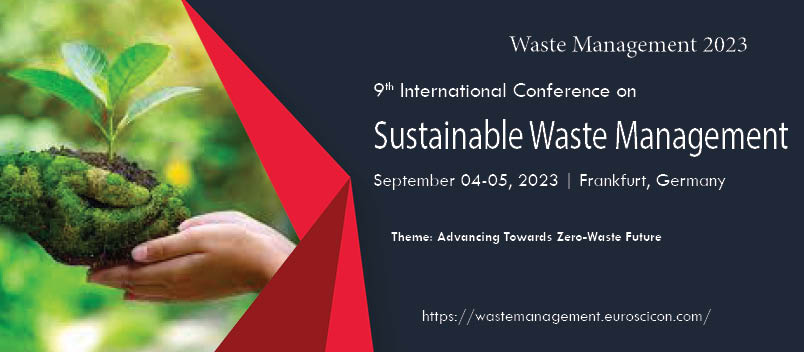WASTE MANAGEMENT 2023
About Conference
ABOUT CONFERENCE
Euroscicon cordially invites all to attend its 9th International Conference on Sustainable Waste Management which will be held during September 04-05, 2023 in Frankfurt, Germany. We hope the Waste Management 2023 unites different researches, innovations and case studies globally in parallel sessions while offering many networking and publishing opportunities. Discover the latest trends and challenges in waste management at this leading conference and learn everything from the hybrid platform has to offer.
Why to Attend?
Waste management is one of the critical problems of modern society due to the ever-expanding volume and complexity of discarded domestic and industrial waste and its implications on environment and health. Society is increasingly aware of the need to establish better practices and safer solutions for waste disposal. This creates a need for more research on current disposal methods such as landfills, incineration, chemical and effluent treatment, as well as recycling, clean technologies, waste monitoring, public and corporate awareness and general education. Since decades we have learned about what we truly value and what truly matters in the regional and global context. At the same time, we have had to relearn the influence of quality research in order to produce knowledge that is applicable outside of the research setting. Hence, we encourage you to share your latest research and let your ideas be heard at the Conference.
Benefits of Waste Management 2023:
a) Keynote introduction alongside connections to excite established researchers.
b) Workshop and symposiums to accomplish the greatest cluster of individuals from the Environmental Science society.
c) A wide track of exhibitors to grandstand the new and rising advancements.
d) Platform to worldwide speculation group to interface with partners in Environment/Civil Engineers area.
e) Links to the political promoting assets remembering the ultimate objective to expand your business and researches.
f) Triumph of Awards, Certificates perceives your sense of duty regarding your calling to empower the incipient research.
Water, Waste and Energy Management Benefits:
• Open board exchanges: Providing an open gathering with specialists from the scholarly world and business to talk about on current difficulties in Water, Waste and Energy Management, where all participants can collaborate with the board took after by a Q&A session.
• Speaker and notice introductions: Providing a stage to all academicians and industry experts to share their exploration contemplations and discoveries through a discourse or a publication introduction.
• Editorial executive gathering: Discussing on development and advancement of management techniques for water, waste and energy. Open access to International Journals and enlisting board individuals and analysts who can bolster the diary.
• Roundtable gatherings: Providing a stage where industry experts meet scholastic specialists.
Business and Exhibitor Benefits:
Over 50+ organizations and international pavilions will be exhibiting at the European Conference of Water, Waste and Energy Management. Exhibitors will include equipment manufacturers and suppliers, systems providers, finance and investment firms, R&D Companies, project developers, trade associations, and government agencies.
In addition to the products and services, you will have access to valuable content, including Keynote Presentations, Product Demonstrations and Educational Sessions from today’s industry leaders.
The 9th International Conference on Sustainable Waste Management has everything you need, all under one roof, saving you both time and money. It is the event you cannot afford to miss!
Target Audience:
- Executives, CEO's of Organizations
- Business Development Managers
- Boss Scientific Officers
- Research and development Researchers from Water, Waste and Energy Management
- Industries.
- Educators, Associate Professors, Assistant Professors
- Ph.D. Scholars
- Patent Attorneys
- Protected innovation Attorneys
- Speculation Analysts
- Affiliation, Association presidents, and experts
- Environmental journalists
- Environmental Protection Agency (EPA) inspectors
- Environmental Compliance Agency workers
- Interpretive naturalists
- Environmental advocates
- Technical writers
- Organizers
- Lobbyists
- Water and air quality engineers
- Civil Engineers
- Solid and hazardous waste engineers
- Pollution control technicians
- Wastewater treatment plant operators
- Programming improvement organizations
- Research Institutes and individuals
- Inventory network organizations
- Assembling Companies
- CRO (Contract Research Organization) and DATA administration Companies
- Preparing Institutes
- Business Entrepreneurs
Sessions&Tracks
Track 1: Waste Management
It can be defined as the collection, transportation, and disposal of garbage, sewage, and other waste products in its most basic form. Waste management entails the treatment of both solid and liquid waste. It also provides a variety of options for recycling goods that aren't classified as garbage during the process. The processes and actions necessary to manage trash from its inception to its final disposal are referred to as waste management or waste disposal. This comprises waste collection, transportation, treatment, and disposal, as well as waste management process monitoring and control, as well as waste-related laws, technologies, and economic systems. Waste can be solid, liquid, or gaseous, with various disposal and management strategies for each. Industrial, biological, residential, municipal, organic, biomedical, and radioactive wastes are all dealt with via waste management. Waste can, in some situations, be harmful to human health.
- Solid waste management
- E-waste Management
- Industrial waste management
- Hazardous waste management
- Plastic waste management
- Industrial and hazardous waste management
- Radioactive waste management
- Agricultural waste
- Food waste reduction and impact on the environment
- Wastewater management
- Waste to Energy
- Various Methods of Waste Disposal
- Landfills
- Incineration/Combustion
- Plasma gasification
- Low Carbon Technology
- Composting
- Waste to Energy
- Special Waste Disposal
- Natural resources management
- Air, soil and water pollution
- Reduce, reuse, recycle and recovery (4Rs)
- Circular Economy
- Advanced technologies in waste management
- Sludge Management
- Environmental Remediation
- Clean management technology
Track 2: Climate Change
Climate change is a change in the statistical distribution of weather patterns that lasts for an extended period of time. The Earth's climate has been changing throughout the history. Just in the last 650,000 years there have been seven cycles of glacial alivence and retreat, with the abrupt end of the last ice age about 7,000 years ago marking the beginning of the modern climate era and of human civilization. Most of these climate changes are attributed to very small variations in Earth’s orbit that change the amount of solar energy our planet receives. At present, the current scenario of the climate change is at alarming levels. The present warming trend is of particular significance because most of it is very likely human-induced and proceeding at a rate that is unprecedented in the past 1,300 years. Earth-orbiting satellites and other technological advances have enabled scientists to see the big picture, collecting many different types of information about our planet and its climate on a global scale. This body of data, collected over many years, reveals the signals of a changing climate.
- Climate Change & Climatology
- Evidence of Climate Changes
- Biodiversity Scenarios
- Carbon Cycle
- CO2 Capture and Sequestration
- Climate Hazards
- Risks of Climate Change
- Energy Policy
- Green Economy
- Deforestation
Track 3: Nuclear Energy
Atomic power is the utilization of atomic responses that discharge atomic vitality to create warm, which most oftentimes is then utilized as a part of steam turbines to deliver power in an atomic power plant. The term incorporates atomic parting, atomic rot, and atomic combination. Nuclear technology uses the energy released by splitting the atoms of certain elements. It was first developed in the 1940s, and during the Second World War research initially focused on producing bombs. In the 1950s attention turned to the peaceful use of nuclear fission, controlling it for power generation.
- Problems with Nuclear Power
- Capabilities of Nuclear Power
- Nuclear Power Plants
- Life Cycle of Nuclear Fuel
- Nuclear Proliferation
- Environmental Issues
Track 4: Fossil fuels
Fossil fuel, any of a class of hydrocarbon containing materials of biological origin occurring within earth’s crust that can be used as a source of energy All fossil fuels can be burned in air or with oxygen derived from air to provide heat. This heat may be employed directly, as in the case of home furnaces, or used to produce steam to drive generators that can supply electricity.
The twentieth century noticed a big diversification of fossil strength consumption, with coal declining from ninety-six percentage of overall production in 1900 to less than 30 percent in 2000. Today, crude oil is the biggest power supply, accounting for round 39 percentage of fossil energy, accompanied with the aid of coal and natural fuel at 33 and 28 percent, respectively.
- Coal Mining
- Petroleum Production
- Oil
- Coal
- Natural Gas
- Fossil fuel technology
- Hydrogen & Fuel Cells
- Oil and gas transportation and pipelines
- Oil reserves and production
- Solar Energy
- Nuclear Energy
- Wind Power & Energy
- Thermal Energy & Management
- Biofules, Bioenergy & Bio-gas
- Biorefineries
- Bio-alcohol, Bioethanol and Biodiesel
- Fuel Chemistry, Technology & Processing
- Energy Conversion & Storage
- Nano Energy
- Environmental & Pollution Issues
- Energy Recycling
- Energy Supply and Economics
- Energy and environmental policy
- Computing, data and energy system modeling
- Clean energy technologies and management
Track 5: E–waste
The composition of e-waste is diverse, containing more than 1,000 different toxic and non-toxic substances. The onset of technological advancement of electrical and electronic appliances is so rapid that new products quickly replace existing models or make certain items of electronic equipment redundant, useless, thereby generating a constant source of e-waste generation. E-waste is created from all electronic: computers, TVs, monitors, cell phones, PDAs, VCRs, CD players, fax machines, printers and many more.
Global E-Waste control market is anticipated to garner $49.4 billion through 2020, registering a CAGR of 23.5% at some stage in the forecast length 2014 - 2020. It's far one of the quickest developing waste streams in emerging as well as evolved areas. The decreased existence spans of electrical, digital and customer digital devices are producing huge E-Waste, which is growing swiftly every 12 months.
- Medical devices
- Plastic Pollution
- Toxic Waste
- Land Pollution
- Motion-Picture Technology
Track 6: Environmental Chemistry
Environmental chemistry is the study of chemical and biochemical processes occurring in nature. These impacts may be felt on a local scale, through the presence of urban air pollutants or toxic substances arising from a waste site, or on a global scale, through depletion of stratospheric ozone or global warming. However, it is important to realize that all forms of matter in our environment whether synthetic or natural are made of chemicals.
The global Environment chemistry marketplace length becomes worth USD 1,023.7 million in 2016, growing at a CAGR of nine.9% over the forecast duration, increasing penetration of the generation in pharmaceuticals region is expected to be the fundamental riding component over the forecast period. It is taken into consideration the green era because of its surroundings-friendly nature and advanced houses in comparison to the batch production tactics.
- Environmental Pollution
- Atmospheric Pollution
- Regional Air Pollution
- Acid Rain
- Stratospheric Ozone Depletion
- Climate Change
- Water Pollution
- Soil Pollution
- Aquatic chemistry
- Atmospheric chemistry
- Bioassays and immunoassay
- Environmental measurement and monitoring
- Environmental monitoring
- Environmental quality parameters related to fresh water
- Gravimetric, titrimetric and electrochemical methods
- Pollution
- Prevention of environmental deterioration
- Quantitative chemical analysis
- Soil Chemistry
Track 7: Reduce, Reuse, Recycle and Recovery
Reduce: this entails the deliberate lowering of the number of plastics an individual uses in their day to day life. Reuse: this involves putting to use plastics that have already been used. This can mean putting them to better use than just throwing them away. Recycle: The basic phases in recycling are the collection of waste materials, their processing or manufacture into new products, and the purchase of those products, which may then themselves be recycled. Recycling can help reduce the quantities of solid waste deposited in landfills, which have become increasingly expensive. Recovery: this entails the insistence on not using plastic but rather finding and using existing alternatives.
Manufacturing products from recycled materials consume less energy and produce less pollution than producing the same items from virgin materials. Reducing our use of virgin materials conserves natural resources like trees, water and minerals.
- Waste Disposal
- Reduce
- Recycle
- Mechanical Recycling
- Energy Recycling
- Chemical Recycling
- Ferrous metals and Nonferrous metals
- Construction and demolition waste
- Domestic refuse
- Benefits of Recycling
- Environmental practice and policy
- Recycling Basics
- Electronic or “e-waste”
- Paper and Plastic Recycling
- Food and Agricultural Waste Recycling
- Industrial Waste Recycling
- Waste water recycling
- Chemical waste recycling
- Advanced Recycling: Physical & Chemical
- Extended Producer Responsibility (EPR)
- Municipal Solid Waste (MSW) / Ocean Waste
- Reuse
- Recovery
Track 8: Waste and Biomass Valorization
Waste and Biomass Valorization is the process of treatment of waste for (landfill) disposal, storage, and in some cases sorting. In the 1990s, depletion of raw materials and socio-economic concerns supported the direct recycling of waste and residues. Various valorization techniques are currently showing promise in meeting industrial demands. Waste and Biomass Valorization is the process of treatment of waste for (landfill) disposal, storage, and in some cases sorting. Various valorization techniques are currently showing promise in meeting industrial demands. Due to depletion of natural resources, increasing greenhouse emissions and awareness of the need for sustainable development in terms of safely reusing waste and biomass, the transformation of waste/biomass to valuable materials and energy is emerging as a strong trend.
A number of exciting fee chains has been diagnosed. specifically, waste from rice, maize, sugar cane, coffee, tea and residual streams from breweries may be valorized to bio-primarily based products for which there is a marketplace, e.g. plastic packaging substances, seedling tubes and kitchen utensils, chemical compounds, and energy. Tren
- Non-Virgin Biomass
- Biomass Valorization in Phytomedicine
- Harnessing Agro-Wastes for Bioethanol Production
- Blended Biomass
Track 9: Solid Waste Management
Solid waste management refers to all activities pertaining to the control of generation, storage, collection, transfer, and transport, treatment and processing, and disposal of solid wastes in accordance with the best principles of public health, economics, engineering, conservation, aesthetic, and other environmental consideration.
- Combustible solid wastes
- Plasma Arc Gasification
- Hazardous-Waste Management
- Sewerage System
- Emissions Trading
Track 10: Renewable Resources
Renewable resources can be described as a rather tricky balancing act. Renewable resource intake and use commonly do not yield decomposition or contribute to global warming. It is easy to recognize the environmental advantages of utilizing the alternative and renewable forms of energy but we must also be aware of the disadvantages. It can be crucial to develop the capacity of electricity that is as large as those produced by traditional fossil fuel generators.
- Hydroelectricity
- Bio Renewable Chemicals
- Natural Resource
- Geothermal Energy
Track 11: Mine Waste & Tailing
Carbon monoxide poisoning is a common problem faced by the workers of coal, gold and many other mines. On the other hand cyanidation problem occurs in gold mines only during ore processing. Current safety systems for mine workers, only monitors environmental concentrations of gas. This is insufficient because toxic exposures effects people at different levels based on their immunity levels. During mining process CO can be emitted which is an odourless gas and lighter than air, it cannot be sensed by workers and effects the haemoglobin range in the body so a CO gas sensor is implemented here in order to detect CO, if the density of CO exceeds inside the mines then the exhaust fan can be switched ON automatically. Recent research on environmental and social risks and business costs in the extractive industry found that environmental issues were the most common cause of disputes, resulting in lost productivity. International best practices and compliance standards have set the benchmark for mining companies together with national legislation.
The mining waste management market is estimated to be 173.64 billion tons in 2017 and is expected to reach 233.56 billion tons by 2022, at a CAGR of 6.1% from 2017 to 2022.
- Climate Change & Climatology
- Evidence of Climate Changes
- Biodiversity Scenarios
- Carbon Cycle
- CO2 Capture and Sequestration
- Climate Hazards
- Risks of Climate Change
- Energy Policy
Track 12: Bioremediation
Bioremediation is becoming the technology of choice for the remediation of many contaminated environments, particularly sites contaminated with petroleum hydrocarbons. Bioremediation stimulates the growth of certain microbes that use contaminants as a source of food and energy.
It is very important to understand that this form of waste remediation uses no toxic chemicals, although it may use an organism that can be harmful under certain circumstances. A gross, but simple explanation of bioremediation is the use of maggots in wound care control. Wounds that have contamination can have maggots introduced to them. The maggots then eat the contamination, allowing the wound to heal correctly. That is a form of medical bioremediation but there are many other types that are used to control different waste contamination.
The worldwide marketplace for bioremediation technology & services marketplace changed into worth USD 32.2 billion in 2016 and is expected to reach USD 65.7 billion by using 2025 at a CAGR of 8.3% from 2017 to 2025.
- The Roles of Microbes in Bioremediation
- Variation in Basic Metabolism
- Nutritional Requirements for Contaminant Destruction
- Indicators of Microbial Activity
- Complicating Factors
Track 13: Waste Treatment Technologies
There are a number of different waste treatment technologies for the disposal recycling, storage, or energy recovery from different waste types. Each type has its own associated of waste Management. Relatively simple waste treatment technologies can be designed to provide low cost sanitation and environmental protection while providing additional benefits from the reuse of resources. These technologies use natural aquatic and terrestrial systems Composition and generation.
- Pyrolysis
- Incineration
- Ion Exchange
- Advanced Oxidation Processes
- Membrane Filtration
- Gasification
- Mechanical Biological Treatment
Track 14: Bio-Energy from waste
The potential for increasing total traditional biomass utilization for energy purposes is limited. The thrust of the activities is therefore twofold, one aim is to broaden the scope of biomass utilization into upgrading and the other aim is to broaden the biofuel base as such. This in turn implies an enhanced focus on fuels for transportation and power generation with respect to traditional biomass and a focus on direct heating for more complex biomass, such as waste etc.
The worldwide waste to electricity (WTE) marketplace size turned into USD 25.0 billion in 2015 and is predicted to witness a sizable increase over the forecast length. Increasing demand for renewable assets is anticipated to propel the global waste to electricity market over the forecast duration. A shift in awareness closer to substitutes along with coal with renewable assets to reduce carbon content is likewise projected to play an essential position in shaping the enterprise.
- Biodiesel
- Biofuels
- Biomass Fraction
- Gasification
- Bio-Oil Upgrading
- Thermo-Chemical Conversion
Track 15: Environmental Impact Assessment
The purpose of Environmental Impact Assessment is to rectify and evaluate the potential impacts of development and projects on the environmental system. It is a useful aid for decision making based on understanding of the environment implications including social, cultural and aesthetic concerns which could be integrated with the analysis of the project costs and benefits.
According to figures compiled by EA, the EIA and sustainable development consultancy work area was worth just shy of £250 million in 2013, which is some 44% higher than where it was at the height of the recession in 2010. Demand for these services has been growing since 2011 as the government prioritised infrastructure investment as a means of stimulating economic growth.
- Environmental Indicator
- Natural Landscape
- Strategic Environmental Assessment
- Economic and Demographic Factors
- Conversation of Biodiversity
Track 16: Landfills
A landfill is a carefully constructed and monitored structure that isolates trash from the surrounding environment. This isolation is accomplished with the use of a bottom liner and daily covering of soil, landfills can create energy. Landfills need expert design as well as professional operators and a proper management to guarantee their functionality.
Americans annually generate approximately 258 million heaps of MSW of which about 53% is deposited in landfills, a percentage that has plateaued in latest years. Currently, 35% of MSW is recycled and 13% is combusted for power production. There's a need to change the way we think about how strong waste is generated, managed, and probably used as a useful resource. We need to recognize that what is automatically discarded can also, in truth, be a reusable aid.
- Plasma Arc Gasification
- Waste Disposal
- Landfill Diversion
- Secure Landfills
- Landfill Gas
- Landfill Fires
Track 17: Waste Processing Industries
The progressive development of the waste processing industry derives directly from the rapid progress in packaging industry. In addition to the inevitable scrap or reject production loads of in-process waste is produced in packaging industry.
Coupled with rapid industrialization and shifting of industries in different regions toward Asia-Pacific, the location has witnessed exponential growth in industrial sports, ensuing in massive quantities of generated industrial waste. This widespread amount of generated waste requires powerful processing and disposal to limit environmental hazards. However, as current commercial waste processing systems are grossly inadequate, the place is anticipated to witness massive investments in the waste recycling and services industry. The commercial waste management market in Asia-Pacific is anticipated to develop at a CAGR of 11.4% between 2014 and 2019.
- Hazardous Wastes
- Carcinogenic
- Chemical Waste
- Biomedical Waste
Track 18: High Performance & Green Buildings
High-performance buildings reflect design excellence. These buildings--often also referred to as "green" or "sustainable"--minimize environmental impact and produce cost savings over their life cycle. These buildings are best designed in an integrative fashion wherein owners, designers and contractors commit from the onset to work together and follow high-performance building principles when addressing critical issues.
The survey shows that global green building interest keeps doubling every three years. Extra people apprehend the monetary and manufacturing value that green homes carry to assets proprietors and tenants, along with the energy and water blessings to the surroundings, that's using the green building industry growth. It’s a win-win for people, planet and the economy.
- New Construction vs. Adaptive Reuse
- Site Selection, Planning and Design
- Energy- and Water-Efficiency
- Use of Renewable Energy
- Indoor Environmental Quality
- Efficient and Environmentally Friendly Materials
- Recycling During and After Construction
- Building Commissioning
Track 19: Trends in Energy Efficiency
Efficient energy use, sometimes simply called as energy efficiency, is the goal to reduce the amount of energy required to provide products and services. Energy efficiency has to be increased at all stages of the energy chain, from generation to final consumption. At the same time, the benefits of energy efficiency must outweigh the costs, for instance those that result from carrying out renovations.
Global energy efficiency has seen positive signs across developed and developing countries. This has resulted in energy savings of 450 million of oil equivalent in 2015. If this can be put in a simpler perspective, the quantity of energy saved could power the whole of Japan for a year. These savings also resulted in reduction of total energy expenditure by $540 billion, another startling fact.
- Smart Cities, Cities That Run Themselves
- Distributed Generation in Smart Cities
- The Electric Vehicle, a Reality Today
- Electric Energy Management from Mobile
- Big Data, the Classic "Information Is Power"
Track 20: Energy Storage
Energy storage is the capture of energy produced at one time for use at a later time. A device that stores energy is sometimes called an accumulator or battery. Energy comes in multiple forms including radiation, chemical, gravitational potential, electrical potential, electricity, elevated temperature, latent heat and kinetic. Energy storage involves converting energy from forms that are difficult to store to more conveniently or economically storable forms. Bulk energy storage is currently dominated by hydroelectric dams, both conventional as well as pumped.
In 2017, Germany invested nearly 80,000 commercial and household operations inside the PV-battery device. Studying the market assessment, the United States is anticipated to install 50,000 extra PV-battery devices annually, by using 2020. The increasing demand for solar PV is envisioned to increase in response to de-carbonization and declining device value of the power quarter across the globe. For this reason, the strength garage market is expected to be majorly driven via the growing solar power marketplace.
- Fossil Fuel Storage
- Mechanical
- Electrical, Electromagnetic
- Biological
- Electrochemical (Battery Energy Storage System, BESS)
- Thermal
- Chemical
Track 21: Strategies to Control Environmental Damage
Many environmentalist and scientist are working to make certain strategies to reduce environmental pollution. In addition to solid waste which we see in our household garbage bins, there are medical, industrial, agricultural and mining wastes. Environment is polluted mostly by improper disposal of waste. Therefore there is a need to keep a check over waste disposal.
Environmental problems are so diverse and diffused that virtually any activity of civilization interacts with the environment. Many environmental pollution problems are local in character and they can be controlled by creating environmental consciousness in each and every citizen. People should be told about the importance of clean atmosphere as well as about the consequences of different types of environmental pollutions. Besides, action is also needed at national level and guidelines may be established internationally by the United Nations Joint Committee of Experts.
- Recycling
- Sewage Treatment
- Green Chemistry
- Basic Aims of Green Chemistry
- Anaerobic Septic Tank Treatment
Track 22: Green Power
Green energy comes from natural sources like wind, water, and sunlight. It is much more environmentally friendly than other types of energy and doesn’t contribute to climate change or global warming. Unlike fossil fuels, green energy sources replenish naturally and are in continuous supply.
The maximum recent update, repute and tendencies inside the U.S. Voluntary green strength marketplace, released in 2017, unearths that about 6.3 million customers procured approximately 95 million megawatt-hours (MWh) of green power in 2016, which represents a 45% increase in the variety of clients and a 19% growth in the quantity income from 2015. The voluntary green power market now accounts for about 28% of all U.S. renewable power income, except massive hydropower.
- Solar
- Wind
- Geothermal
- Biogas
- Edible Biomass
- Hydroelectric Sources
Track 23: Water Conservation Program
Water conservation includes all the policies, strategies and activities to sustainably manage the natural resource of fresh water, to protect the hydrosphere, and to meet the current and future human demand. Population, household size, and growth and affluence all affect how much water is used. Factors such as climate change have increased pressures on natural water resources especially in manufacturing and irrigation.
- Rainwater Harvesting
- Habitat Conservation
- Fresh Water
- Water Utilities
- Irrigation
Track 24: Alternate Water Resources
Alternative water is often treated to non-potable standards, meaning it is not safe for human consumption. Common uses of alternative water include landscape irrigation, ornamental pond and fountain filling, cooling tower make-up, and toilet and urinal flushing.
Water shortages have already been faced within the examine place because of droughts, and that they had been conquer by using managing call for.
- Harvested Rainwater from Roofs
- Onsite Storm Water
- Grey Water
- Discharged Water from Water Purification Processes
- On-Site Reclaimed Wastewater
- Captured Condensate from Air Handling Units.
Track 25: Environment Legislation
Environmental legislation is the collection of laws and regulations pertaining to air quality, water quality, the wilderness, endangered wildlife and other environmental factors. The umbrella of environmental legislation covers many laws and regulations, yet they all work together toward a common goal, which is regulating the interaction between man and the natural world to reduce threats to the environment and increase public health.
- Waste Management
- Contaminant Clean-up
- Chemical Safety
- Trans-boundary Responsibility
- Public Participation and Transparency
- Precautionary Principle
- Prevention
- Polluter Pays Principle
Track 26: Waste Recycling and Management
Waste management or disposal is all the activities and actions required from its inception until its final disposal to manage the waste. This covers among other issues, waste generation, storage, care and recycling along with control and enforcement. It also contains the legislative and administrative system pertaining to waste management including recycling guidelines etc.
- Recycling - Application & Technology
- Cementitious Binders Incorporating Residues
- Industrial By-products
- Recovery of Metals from Different Secondary Resources (Waste)
- Recycling of Carbon Fibers
- Recycling of Construction and Demolition Wastes
- Recycling of Packaging
- Separation of Large Municipal Solid Waste
- Recovery of Construction and Demolition Wastes
- Waste Electrical and Electronic Equipment Management
- Developments in Collection of Municipal Solid Waste
- Recycling in Waste Management Policy
Track 27: Pollution Control
The process of minimizing or eliminating the release of pollutants into the environment is known as pollution control. Pollution control is any of a number of techniques used to limit the environmental damage caused by the discharge of dangerous substances and energies. Waste disposal systems, such as sanitary landfills, automotive emission control systems, sewerage system sedimentation tanks, electrostatic precipitation of pollutants from industrial gas, and recycling are all examples of pollution control methods. Pollution occurs when toxins are introduced into the natural environment and cause harm. Pollution can be in the form of any substance (solid, liquid, or gas), or it might be in the form of energy (such as radioactivity, heat, sound, or light). Pollutants are either foreign substances/energies or naturally occurring pollutants that contribute to pollution.
- Pollutants
- Climate Change and Global Warming
- Recycling & Waste Management
- Bioenergy and Biofuels
- Bioremediation
- Environmental Chemistry & Engineering
- Green Nanotechnology
- Industrial Pollution & Control Devices
- Environmental Risk Management and Environmental Protection
- Groundwater Issues
- Health and Environment
- Oil Spills
- Soil Pollution and Treatment
- Wastewater Pollution control
- Noise Pollution
- Deforestation
- Marine Pollution
- Environmental Monitoring and Management
- Atmospheric science and air pollution control
- Solid Waste Pollution Control and Resource Utilization
- Acid rain and greenhouse gases
Market Analysis
MARKET ANALYSIS
Recycling is the most common way of transforming junk into new items and materials. this idea regularly considers the recuperation of energy from squander materials. The limit of a substance to recapture the characteristics it had in its underlying state decides how recyclable it's. a substitute for a customary waste disposal can assist with saving assets and decrease ozone depleting substance discharges. Furthermore, it can restrict the use of new unrefined components and stop the misuse of possibly usable materials, diminishing energy use, contamination (from burning), and water tainting (from landfilling). inside the "Decrease, Recycle, and Reuse" squander order, reusing is the third and essential component of contemporary rubbish decrease.
As per the Agency of Global recycling, squander metals are used in near 45% of hardened steel fabricating around the world. Also, a portion of the 400 million tons of new paper produced year is produced using reusing board and paper.
Because of the adverse consequences of the financial emergency and changes in the worldwide economy, the metal recycling business has encountered a major change. along with the requirement for vehicles, fabricated items, and structures, metal and junk are more popular. predictable with Featured discussion, urbanization in non-industrial countries is driving the metal recycling market.
Squander yield inside the monetary framework upgrades ecological supportability. Certain ISO norms are pertinent to waste management, as ISO 14001:2015 for ecological administration control of Waste practice and ISO 15270:2008 for plastics squander.
Reusing additionally incorporates fertilizing the soil and different purposes of biodegradable rubbish, including food and nursery squander. Recycling materials are either moved to a family reusing focus or gathered from curbside receptacles, after which they're arranged, cleaned, and handled again to make new materials for creating new products. inside the best situation, recycling material prompts another stockpile of that equivalent material; for example, old office paper would be changed into new office paper, and It would be changed over from polystyrene froth into new polystyrene.
Metal jars, for example, are frequently made more than once and everlastingly without losing their immaculateness. Delivering the indistinguishable thing from unrefined substances or different sources is often excessively troublesome or costly for different materials, subsequently "reusing" numerous things and materials involves utilizing them again to make new materials (for instance, paperboard). One more kind of reusing is the recuperation of parts from convoluted products in view of their innate worth, (for example, gold from printed circuit sheets and lead from car batteries) or their risk status (e.g., expulsion and reuse of mercury from thermometers and indoor regulators). Starting points of History Fighting Post-The Second Great War Items. The recycling gear and apparatus market is anticipated to outperform US$ 1.2 billion (EUR 1.05 billion) by 2025 on the grounds that the significance of effective reusing innovation rises. steady with the review, baler presses will control the hardware area with a 30% portion of the entire reusing gear and apparatus market. With an extended income of US$ 390 million by 2025, experts foresee that metal baling will grow at a build yearly pace of development of 5.7% over how much 2018 to 2025. Over the resulting eight years, "significant increments" are expected inside the hardware and apparatus industry for plastic recycling. Somewhere in the range of 2018 and 2025, this specialty market will grow at a 6.3% yearly rate, with an objective worth of US$ 470 million.
Predictable with the report, 7.7 billion a lot of plastic are created every year across the world, of which 5.4 billion tons aren't reused. By 2025, the market inside the Asia Pacific region is supposed to be worth more than US$ 450 million, with China being a major type of revenue. Waste management PET jugs regularly incorporate trash pickup, arranging, destroying, and forming processes. Over the extended time of 2018-2023, promoting research Future (MRFR) predicts a CAGR of 5.28% inside the overall PET jug Waste management market. The commercial center for reusing PET containers was assessed to be around USD 4,381.3 Mn in 2017 and is expected to be worth USD 5,933.6 Mn by the highest point of 2023.
Numerous countries value their inventive ways to deal with Squander The board and high Waste management rates. Among them are Sweden, South Korea, and Germany, which is normally adulated as the Waste management title holder.
Germany has executed a few techniques throughout the course of recent years that have impressively worked on its Waste Administration and raised its waste management rates, as required trash arranging regulations and a profoundly successful store discount program.
Reused plastics are expected to have less helpful mechanical qualities and solidness than virgin materials, and this is frequently ordinarily credited to synthetic decay. Nonetheless, we as of late found that pre-shopper polypropylene (pre-RPP) wasn't artificially harmed and had practically similar atomic qualities as virgin polypropylene. during this work, we saw that by applying a spread of warm medicines to reused pre-buyer polypropylene, we could gain characteristics that were like those of virgin polypropylene. Furthermore, we utilized SEM to appear at the break surfaces. The discoveries demonstrated that the mechanical characteristics were emphatically associated with the inward design, and on the off chance that we could deal with the internal construction of pre-RPP, we ought to constantly have the option to build its mechanical properties and sturdiness to such an extent that they are practically indistinguishable from those of VPP.
Largest waste and recycling companies
- Waste Management
- Republic services
- Waste connections
- Veolia
- GLF Environmental
- Clean Harbors
- Stericycle
- Cleanaway Waste Management
- Us Ecology
- Befesa
- Pure Cycle Technologies
- Li-Cycle
- Schnitzer Steel
- 374Water
- Rubicon Technologies
- Cielo Waste Solutions






















